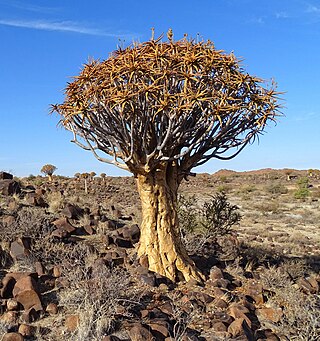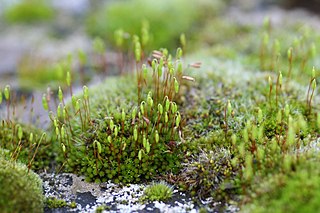
Jasmine is a genus of shrubs and vines in the olive family of Oleaceae. It contains around 200 species native to tropical and warm temperate regions of Eurasia, Africa, and Oceania. Jasmines are widely cultivated for the characteristic fragrance of their flowers. Additionally a number of unrelated species of plants or flowers contain the word "jasmine" in their common names.

Aloidendron dichotomum, formerly Aloe dichotoma, the quiver tree or kokerboom, is a tall, branching species of succulent plant, indigenous to Southern Africa, specifically in the Northern Cape province of South Africa, and parts of Southern Namibia.

Jasminium dichotomum, the Gold Coast jasmine, is a species of jasmine, in the family Oleaceae. It is an evergreen climber which grows as a rambling shrub or woody vine. The flowers are quite fragrant and open at night, coloured pink when budding then white; these appear at the leaf axils in cluster. It blooms year round. The leaves are opposite. The fleshy fruit is small.

Bryaceae is a family of mosses.
Bryum dixonii, commonly known as Dixon's threadmoss, is a moss endemic to Scotland. The species occupies montane habitats, and although rare it has a wide distribution including the central and north-west Highlands, and the islands of Skye, Rùm and St Kilda. Originally discovered on Ben Narnain, Argyll, in 1898 by Hugh N. Dixon, it was not seen again until 1964 when found by Ursula Duncan at Juanjorge in Glen Clova in Angus. As of 2000 there was no species action plan for its protection.
This is a list of the flora of the South Sandwich Islands, a group of islands in the subantarctic Atlantic Ocean, part of the British overseas territory of South Georgia and the South Sandwich Islands. The list contains flora in the strict sense; that is, plants only. It comprises a single species of vascular plant, 38 mosses, and 11 liverworts. Unusually, not a single species is known to have naturalised on the islands; all are presumed native.

The West Cornwall Bryophytes Site of Special Scientific Interest is a group of seven locations of former mining activity, that form a single SSSI and Important Plant Area in western Cornwall, England, United Kingdom. The site is noted for its biological characteristics and derives its name from the rare bryophyte species found there.

Bryum is a genus of mosses in the family Bryaceae. It was considered the largest genus of mosses, in terms of the number of species, until it was split into three separate genera in a 2005 publication. As of 2013, the classification of both Bryum and the family Bryaceae to which it belongs underwent significant changes based on DNA studies.

Bryum argenteum, the silvergreen bryum moss or silvery thread moss, is a species of moss in the family Bryaceae. It is one of the most common mosses of urban areas and can be easily recognized without a microscope.
Bryum blindii, commonly known as Blind's bryum moss, is a species of moss belonging to the family Bryaceae.

Ptychostomum pseudotriquetrum, commonly known as marsh bryum, is a species of moss belonging to the family Bryaceae.

Gemmabryum caespiticium, handbell moss, is a species of moss belonging to the family Bryaceae.

Ptychostomum capillare, formerly designated as Bryum capillare, is a species of moss belonging to the family Bryaceae. It is known as capillary thread-moss.
Ptychostomum cyclophyllum, round-leaved bryum, is a species of moss belonging to the family Bryaceae.
Bryum funckii is a species of moss belonging to the family Bryaceae.

Ptychostomum schleicheri, the Schleicher's bryum moss, is a species of moss belonging to the family Bryaceae.
Gemmabryum is a genus of moss in the family Bryaceae. It was separated from the genera Bryum and Brachymenium in 2005. It has been argued that the correct name for the genus is Osculatia.










